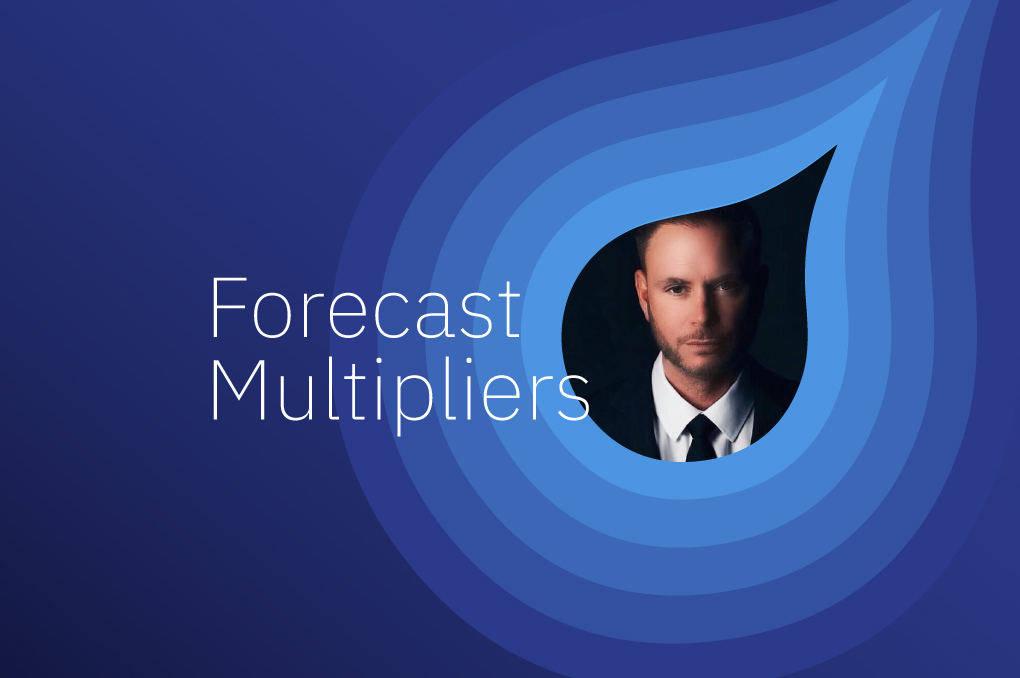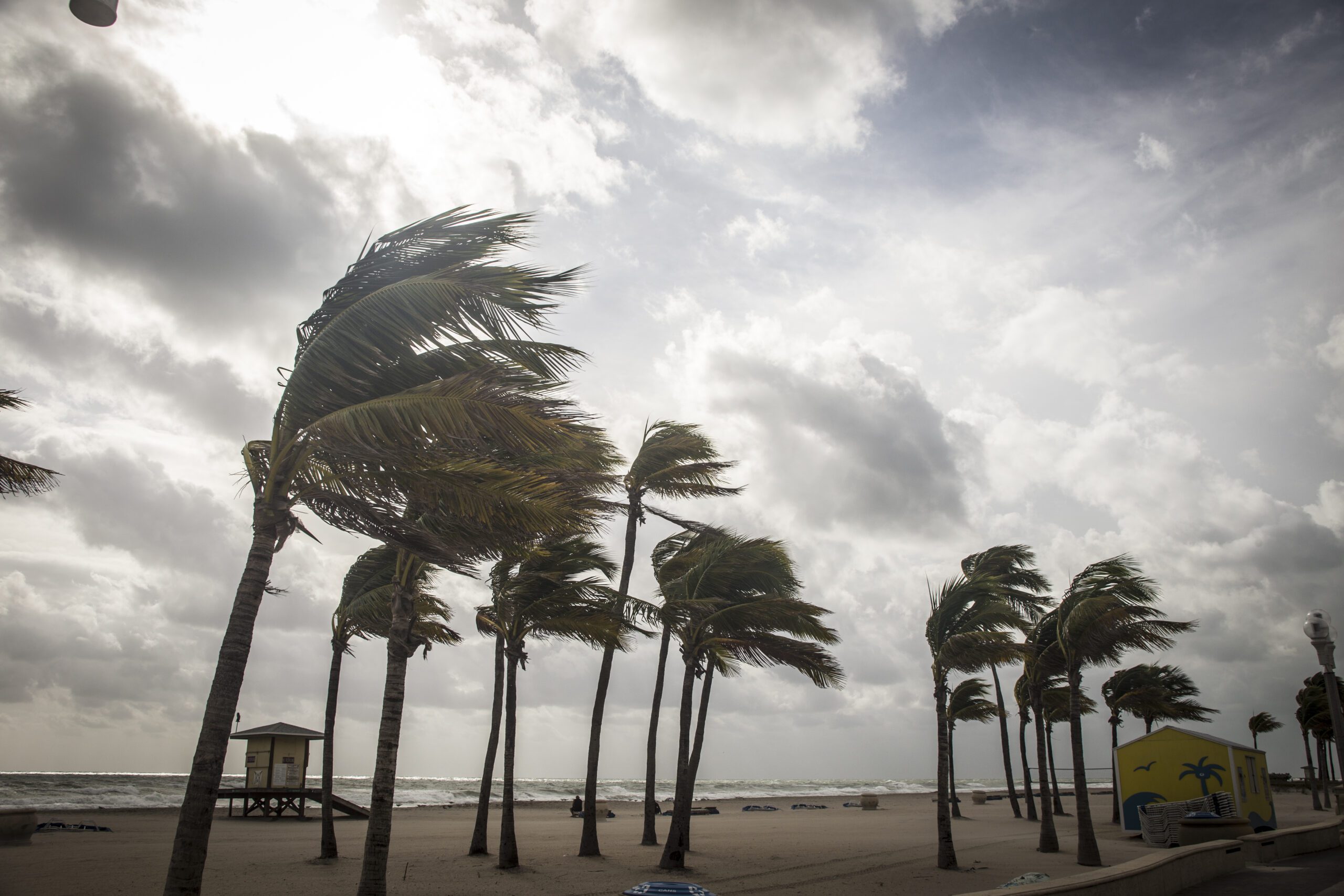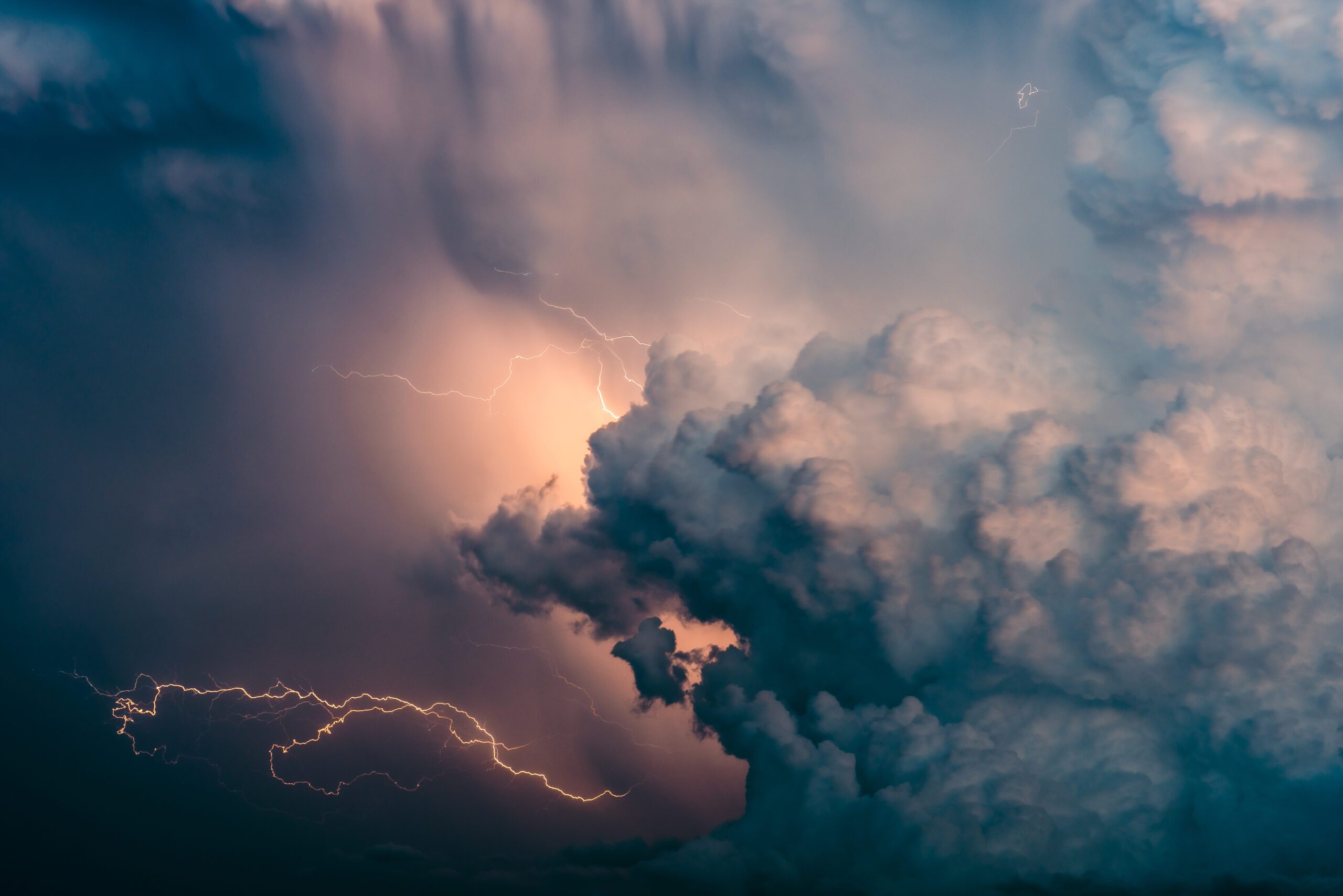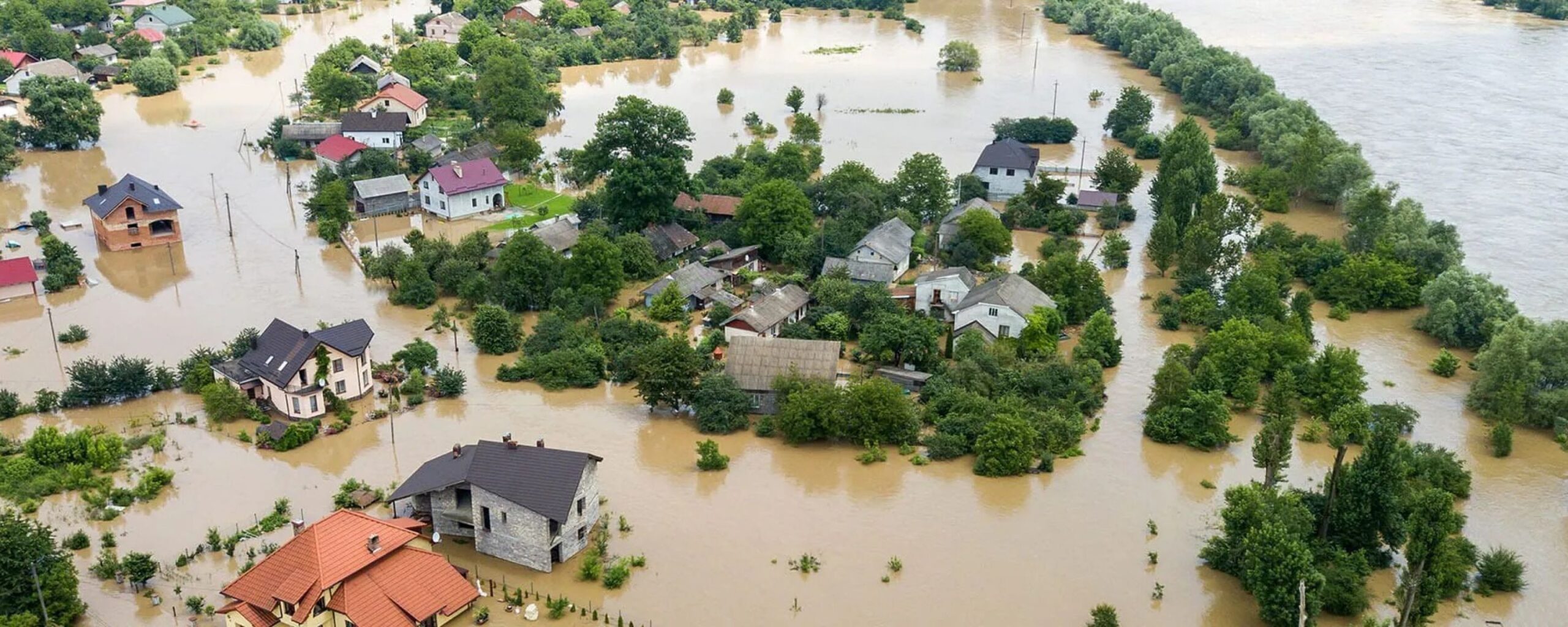Weather intelligence for the future: Crafting a strategic enterprise approach to changing environmental conditions
Continue readingWhile the 71st year of the Cannes Lions Festival of Creativity is officially in the rearview, the excitement and inspiration are still very much alive at The Weather Company. And right now, it’s clear the industry sits at a pivotal moment, with weather data and insights as key elements to its great potential.
From driving creative momentum, to bringing a renewed vigor and commitment to innovation and positive change, weather was a topic of many conversations, meetings, and thought leadership sessions. Our single takeaway: Weather data is no longer “nice to have” but a “must have” for understanding consumer behaviors and motivations, making more informed business decisions, and delivering action against our changing climate, for the back half of the year and beyond.
For some brands and businesses, a weather strategy may already be part of your broader marketing strategy; for others, it may be a new, innovative approach. Regardless of where you stand, here are three need-to-knows from this year’s Festival, brought to you by your Chief Weather Officer.
1) No cookies, no problem…for these brands
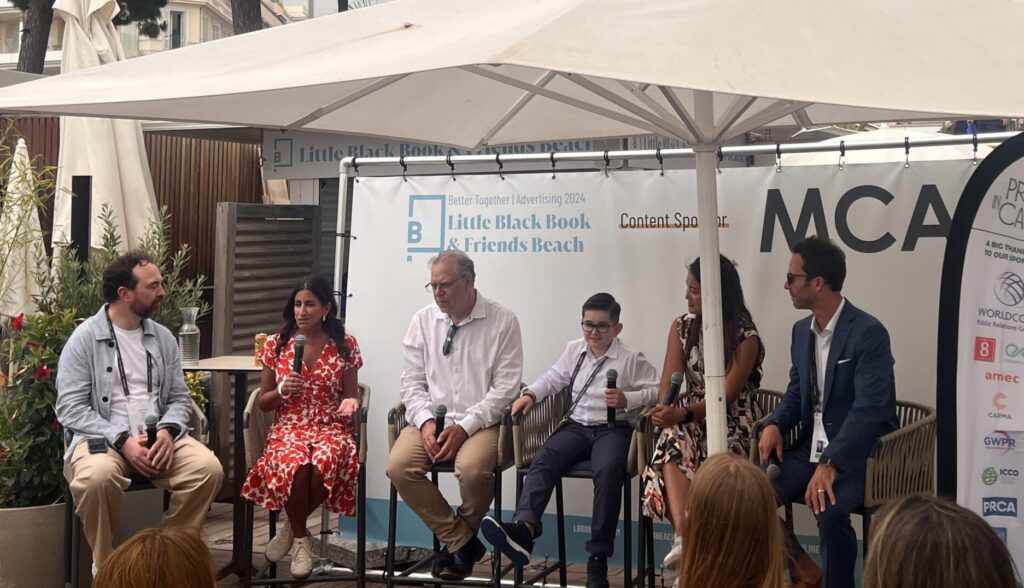

Randi Stipes, Chief Marketing Officer, at Little Black Book & Friends Beach and The Marketing Academy Villa stages
Data signal loss with cookies eventually going away has been an on-going topic in many Ad Tech circles and programming, and this year was no different. While the industry waits for cookies to fully deprecate, many brands and marketers are focused on defining their first party data and audience strategies, understanding clean room solutions, and adopting alternative privacy-forward data signals. Regardless of Google’s timeline, weather data has long served marketers in driving business growth while protecting consumer privacy.
This year, we partnered with four leading brands — Milk-Bone®, Chloraseptic, EcoFlow, and Tyson Foods — to showcase the value of a weather strategy. We call them the ‘Rainmakers of Marketing,’ smart brands that understand the deep connection between weather and consumer behaviors, moods, and motivations and are winning within their categories, in large part by leveraging weather to supercharge their campaigns. Our partnership with Milk-Bone, Chloraseptic, EcoFlow, and Tyson Foods were on display 24/7 across three digital out-of-home billboards along La Croisette (because Cannes Lions is the greatest opportunity to display OOH, of course). If you missed them, check them out here.
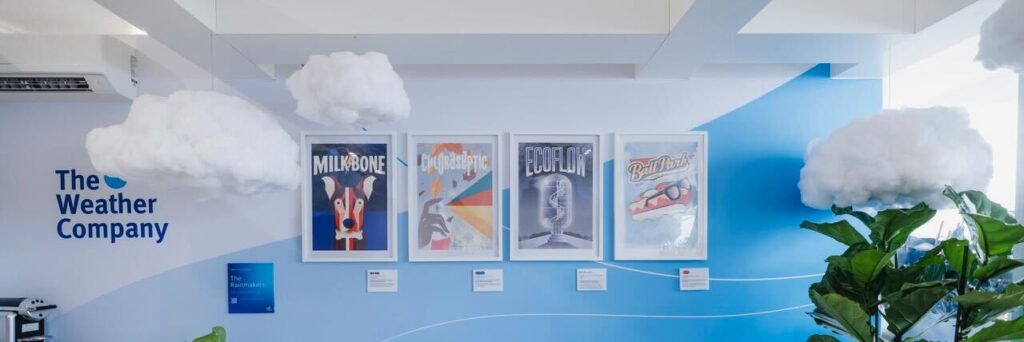
Rainmakers of Marketing poster art showcased in The Weather Company meeting suite at MediaLink Beach (L to R): Milk-Bone®, Chloraseptic, EcoFlow, and Tyson Foods
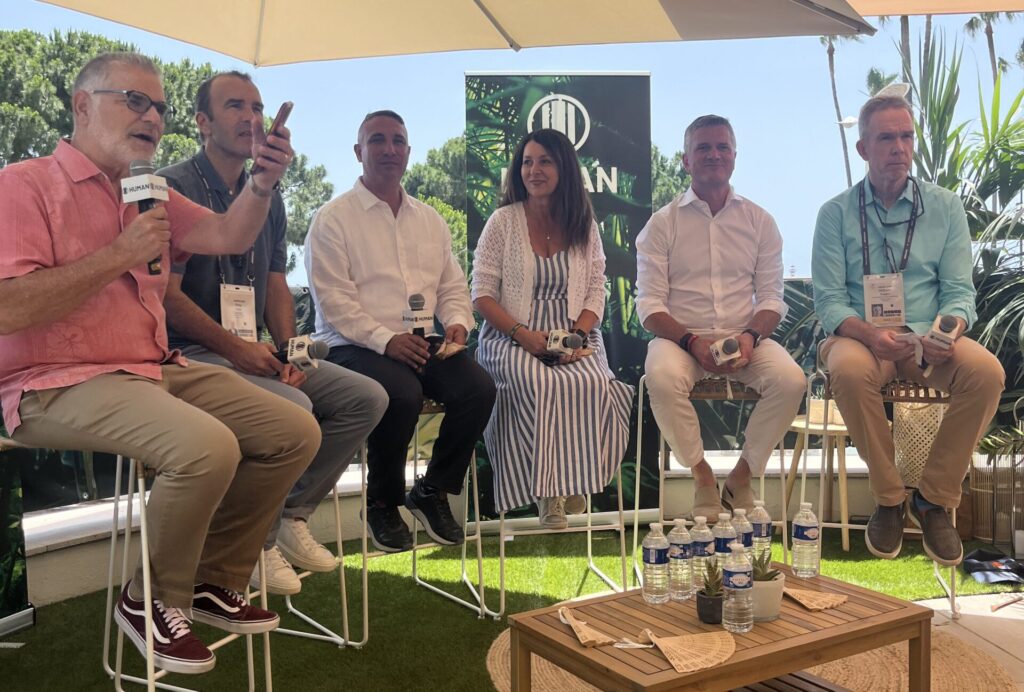

Sheri Bachstein, CEO, at The Haven x HUMAN and MediaLink Beach stages
2) AI: moving from conversations to commitments
Last year, the conversation around AI took on a very different look. Across the Festival mainstage and along La Croisette, creatives, agencies, brands, publishers, and creators were discussing AI’s advantages and disadvantages, debating how human creativity and thinking would play alongside the latest advancements and detailing how it would improve efficiency, performance, and outcomes across the advertising landscape. This year, those conversations shifted from ideation to application.
For The Weather Company, AI has long been foundational to our business. As the world’s most accurate forecaster,1 we combined AI, advanced weather science, and technology with human expertise to keep consumers informed, whether it’s how to dress for cooler-than-average temps at this year’s Festival or preparing for the most active Atlantic hurricane season (which is happening right now). Our deep expertise in AI doesn’t stop there. This June, we introduced the broader market to The Weather Engine™, a data and insights platform built on AI based multivariate models aimed to deliver deeper insights and visualizations on the impact of weather with zip code level precision. While there’s immediate benefit for advertisers when it comes to media activation and targeting, the real magic happens when we partner to create bespoke insights through the application or Machine Learning and AI against first party, third party, and other actionable data sets, specific for businesses and KPIs across advertising, marketing, and the entire enterprise.
Read how SC Johnson’s Off!® brand, America’s #1 trusted Insect Repellent brand in 2024, is finding success with The Weather Engine.

Cannes Lions Mainstage with Randi Stipes, Chief Marketing Officer
3) Weather: no longer small talk
From Sustainable Development Goal Lions, to reducing both waste and carbon emissions associated with the event, sustainability and climate continued as a core theme at this year’s event. The advertising industry, and the marketers behind the brands, sit in a unique position to shape public behavior and drive action, and that’s exactly why Cannes Lions was the perfect stage to proclaim the reality of changing weather and influence collective climate action — helping create connections between the weather and all aspects of human well-being.
We were honored to bring ‘Weather Kids,’ our joint campaign in partnership with the United Nations Development Program and the World Meteorological Organization, to the Cannes Lions mainstage. The conversation centered on a projected forecast for 2050, and how it might change depending on the climate actions we take today. Missed this session? If you have a Cannes Lions pass (physical or digital), you can watch it on demand, or read the ungated abridged version in the Cannes Lions Daily. Either way, be sure to take the two minute action of signing the pledge on behalf of the kids in your life to change the future for the next generation.
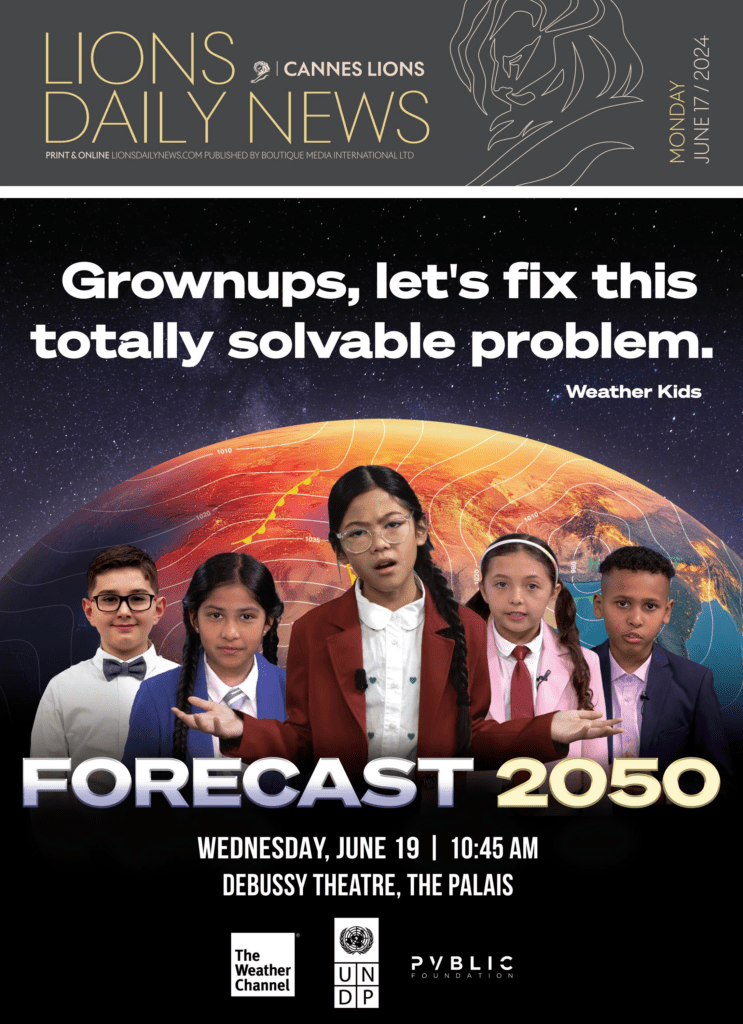
Cover image of Lions Daily News featuring ‘Weather Kids’ campaign
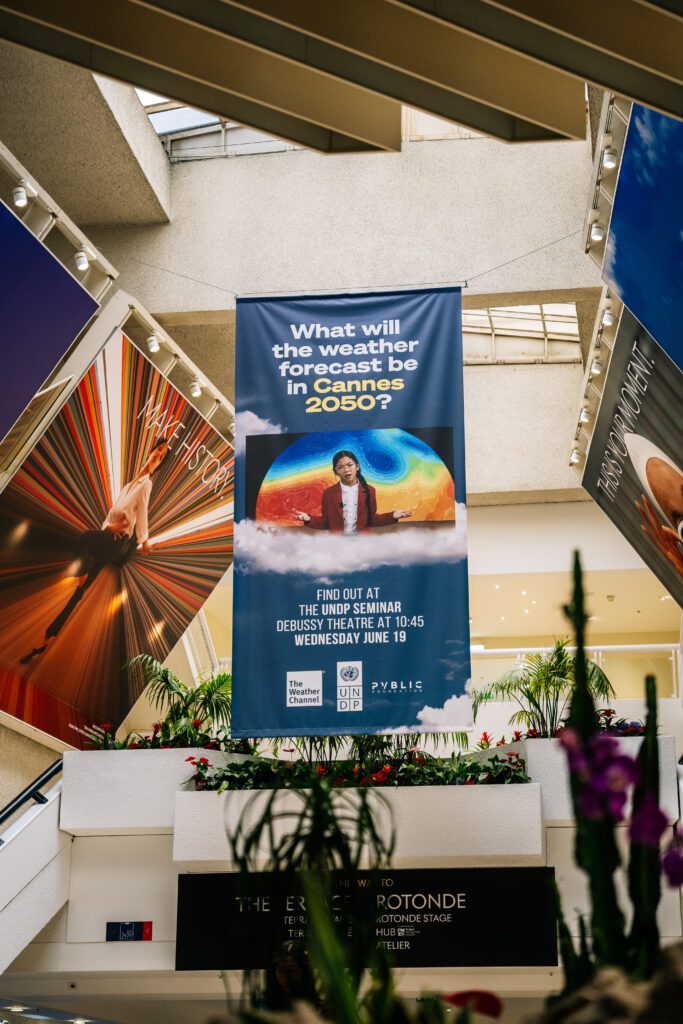
‘Weather Kids’ campaign banner hanging inside the Palais des festivals
Whether you attended the Festival or not, we’ll leave you with one final note, or perhaps action…
You either develop a weather strategy…or a strategy for defending why you didn’t develop a weather strategy. We’re here to help with the former.
Consider us your Chief Weather Officer.
Let’s talk
What’s your weather strategy? To learn more about harnessing the power of weather to increase engagement and drive growth, contact our advertising experts today.
Contact us1 ForecastWatch, Global and Regional Weather Forecast Accuracy Overview, 2017-2022, commissioned by The Weather Company
Sunrise to sunrise, weather influences our lives every day. For some, the weather determines if they can work outside or the best time to go for a run. For others, the weather affects how they manage their seasonal affective disorder or when to stock up on allergy medication. Checking the weather forecast isn’t just a daily habit, it’s a life habit.
As the world’s most accurate forecaster overall,1 we have a front-row seat to how changing weather is impacting consumers’ lives. Tornado alley has widened2, allergy “season” is longer3, and daily high-temperature records continue to be broken4. In fact, did you know that 2023 was the earth’s warmest year on record?5 As a result, consumer needs are changing and the utility of weather in our lives needs to reflect these realities. We knew we must provide more to our 360 million+ average global monthly users.6
A tool for more than just every day—but every lifestyle
Together, with input from our audience, we set out to reimagine a weather experience that better anticipates users’ needs and delivers personalized insights in the moments that matter—from informing consumers about conditions that can affect breathing in their area to how to maximize time outdoors. Our ambition? To create a seamless, intuitive user experience, getting people what they need quickly within a modernized design that is as inspiring as it is functional.
We re-examined the tone of our experience as well. More than 80% of surveyed respondents reported they agreed that weather influences their moods and emotions, and 67% noted that weather impacts their physical health.7 While we will always prioritize safety during severe weather moments, we felt compelled to surface moments of good as well. Not only telling customers that it’s going to rain, but also when their next sunny day is. We wanted to offer more of a balance between critical severe weather information and insights into how weather can impact their passion points like wellness, travel, pets, gardening and more. Ultimately giving people information to help them live smarter and happier lives.
This approach created a distinct challenge—in which we needed to personalize an individual’s unique, hyperlocal interests and must-haves, while simultaneously being a trusted resource for more than 45 million daily visitors who visit our digital properties, on average8. Especially for our mobile app audience who visits an average of 28 times a month9. Solving this issue wouldn’t be possible without our combination of data with AI technology to quickly determine the most impactful information.
Basic weather data continues to proliferate. Thanks to the increased accessibility of AI, we’re seeing more businesses enter the weather sector. But not all weather providers are created equal—that’s where The Weather Company’s decades of meteorological expertise, deep understanding of consumer behavior, and data-science proficiency in uncovering insights pay off. In a world where seasonal norms are being upended and many consumers prioritizing their wellness10, accuracy and trust have never mattered more.
The intersection of consumer and marketer needs
Weather isn’t the only changing element. We’re all experiencing the unique transformation underway in marketing and media, one that aims to consider consumers’ privacy—a shift I applaud. Weather, as a digital consumer experience and data signal, provides marketers with contextual, timely and privacy-forward data that is necessary to navigate this new advertising paradigm.
While reimagining our consumer weather experience, we thought hard about the unique intersection we occupy between consumers and marketers. This app creates spaces for more storytelling freedom, a canvas that enables marketers to align their stories with the unique, weather-related needs of millions of consumers.
We focused on elevating and modernizing our advertising integrations that contextualize a brand’s message to specific consumer needs. Whether it’s capturing the first impression of the day as users are in a planning mindset with our Integrated Marquee or creating a deeper connection through wellness experiences like our Allergy Forecast, every integration is built from a consumer-first perspective.
Welcome to The Weather Channel’s fully reengineered flagship app
As we all look to the future, cookieless targeting solutions will only increase in importance. Given the reach and frequency of The Weather Channel digital properties, and its recognition as one of America’s most trusted brands,11 our suite of data-targeting solutions is designed to help mitigate the risk many brands are up against. From a robust weather-targeting suite to contextual signals like health or travel and first-party audiences like pet owners, parents and new homeowners, our goal is to help marketers succeed in the short-term and long-term.
We can’t escape the changing atmosphere of our earth or our industry. Keeping pace with the weather means keeping pace with consumer needs at any given moment. The relaunch of The Weather Channel app is the first evolution of an engaging experience that can empower people to thrive amidst increasingly volatile weather, and propels brands to succeed within a shifting advertising landscape.
We welcome you to experience the next chapter of weather with us and enjoy the next sunny day to its fullest. Download the new app for iOS in the Apple App Store and Android later this year.
It’s Dynamic. Bold. Personal. I’d love to hear if you feel the same.
To learn more, visit our press release.
1 ForecastWatch, Global and Regional Weather Forecast Accuracy Overview, 2017-2022, commissioned by The Weather Company
2 Fischetti e alt, “Watch Out: Tornado Alley Is Migrating Eastwar”, May 11, 2023
3 ”Yes, Allergy Seasons Are Getting Worse. Blame Climate Change”, May 23, 2023
4 “US, Europe Heat Records Smashed This Summer”, The Weather Channel, August 2, 2023
5 Jonathan Erdman, “It’s Official: 2023 Was The Earth’s Warmest Year On Record”, January 9, 2024
6 Based on the average of the total monthly (non-unique) users for January – June 2023 across The Weather Company digital properties and consumer products (weather.com, The Weather Channel app, Weather Underground app, wunderground.com, Storm iOS app), according to The Weather Company internal data
7 Harmony Bay Wellness: ‘The Effect of Weather on Your Mood’, Leading global management consulting study, March 2023 n=1,993
8 Based on the average of global daily unique visitors monthly for February – July 2023 across The Weather Company digital properties and consumer products (weather.com, The Weather Channel app, Weather Underground app, wunderground.com, Storm iOS app), according to The Weather Company internal data
9 Based on the average global app monthly visits / global monthly unique visitors for January 2023 – August 2023 across The Weather Company App Properties, including The Weather Channel and Weather Underground, according to The Weather Company internal data
10 The Weather Company AI Health & Weather Impact study, August 2020
11 Named one of 2023’s most trusted brands by Morning Consult, May 2023
The Weather Channel brand was the #9 most trusted brand in the US. The surveys were conducted from 3/3/2023 through 4/3/2023, among a nationally representative sample of 799 to 8,434 U.S. adults. Also named most trustworthy media organization in an April 2023 poll by YouGov: Linley Sanders, “Trust in Media 2023: What news outlets do Americans trust most for information?”, YouGov, May 8, 2023.
Emergency alert software plays an important role for weather broadcasters, serving as a critical tool for disseminating timely and potentially life-saving information during severe weather events.
However, not all emergency alert software is made equal. The effectiveness of these systems hinges on their design, features, and integration capabilities. To make an informed decision when choosing the best emergency alert software, it’s crucial to understand its multifaceted applications.
What is emergency alert software used for?
Emergency alert software helps bring severe weather alerts and warnings to the air. The software integrates with your existing broadcasting systems to deliver automated notifications from the National Weather Service to local audiences. These alerts can be delivered via TV broadcasts, email, text, push notifications, and a variety of other channels. According to Weather Company research done with Magid, during severe weather about 75% of viewers check their local broadcast or mobile alerts for convenient and trusted information. Thus it’s important to employ software that delivers the message to where your audience is.
Sophisticated software ensures severe weather warnings pop up on viewers’ radars in real time. Handling this manually is nearly impossible, especially with the amount of platforms requiring content and the need for repeated updates as events evolve. Emergency alert software automates severe or dangerous weather notifications, freeing up broadcasters to focus on delivering additional instructions and context. The software also supports ongoing coverage by streamlining the creation of maps and other visuals when time is of the essence.
How does emergency alert software work?
There’s a wide range of emergency alert software available, each with varying features and capabilities. However, its fundamental purpose remains the same: to rapidly communicate critical information during severe weather events.
Emergency alert software enables you to:
Design alerts
Effective emergency alert software allows you to design alerts that capture attention and deliver information clearly for TV broadcast viewers. The visual appeal of alerts is crucial, ensuring that viewers immediately grasp the severity, location, timing and nature of the weather event. Sound also plays an important role—viewers should immediately know that an important alert is occurring.
Set trigger conditions
Customizing trigger conditions is essential. Emergency alert software should enable you to set specific conditions that automatically activate alerts. Some common trigger conditions could include hazardous air quality, hurricanes, tornadoes, and landslides. Setting these triggers ensures a proactive approach, keeping your audience informed without manual intervention. Based on the severity level, these alerts can either be deployed manually or automatically. When no internet is available, these conditions should be able to trigger locally.
Test alerts regularly
Regular testing is a key component of emergency alert preparedness. Your chosen software should facilitate easy and frequent testing to ensure that alerts function as intended. This includes checking the visual elements, message delivery, and overall effectiveness.
Where can emergency weather alerts be transmitted?
Emergency weather alerts are only useful if they can reach their target destination. Being able to transmit these alerts in a timely fashion across multiple channels, such as television broadcasts and mobile app push notifications, helps ensure audiences remain aware of hazardous weather conditions.
Weather broadcasts
Emergency weather alerts are a staple of weather broadcasts. The software should seamlessly integrate with your broadcasting systems, allowing for the swift dissemination of critical information to your audience.
Mobile alerts
In an era of digital connectivity, smartphones are a primary source of information for many individuals. According to Magid, during severe weather 38% of viewers check their smartphones due to ease and speed. Ensure that your emergency alert software extends its reach to mobile alerts, maximizing the dissemination of crucial information.
OTT
More and more viewers are engaging with over-the-top (OTT) media services as a way to consume information. OTT goes beyond broadcasts, with 40% of viewers using a steaming device as a primary source for watching weather via TV according to Magid. It’s crucial to have a weather alert system that can convey emergency alert information through OTT channels.
9 features to look for in emergency alert software
Investing in emergency alert software requires a careful consideration of features to ensure optimal functionality. Without prioritizing these features, your organization can encounter unforeseen issues that prevent audiences from receiving timely weather updates when they need them most.
Let’s take a look at nine of the top features to look for when evaluating emergency alert software.
1. Automated alerts
Automated weather alerting, supported by advanced technology, is a cornerstone of effective emergency messaging software. It not only covers everyday weather forecasts but also proves invaluable during severe storms. Automated alerts are low-maintenance, ensuring accurate and up-to-date information for your broadcasts. They enhance safety, keep viewers informed, and contribute to higher engagement rates.
2. Customizable weather graphics
Visual representation is key in weather broadcasting. Look for emergency alert software that offers customizable weather graphics. These graphics should provide a clear and engaging visual representation of weather forecasts, providing viewers with detailed information about storm locations and other relevant extreme weather events.
3. Comprehensive weather map
A robust weather map feature is essential for conveying complex meteorological data to your audience. Weather map software should allow meteorologists to create, analyze, and visualize data such as distinct area maps effectively. In the case of severe weather, creating a hurricane track can serve as a supplement to details such as position, wind speed, or direction that help to keep your viewers informed on the latest status of the storm. These weather maps can also be used to display what areas should be evacuated or information on a local level. All without pre-rendering or having to employ another graphics system. An efficient emergency alert software can go beyond alerting and the standard crawl, it should be a valued asset in your toolkit.
4. Cloud capabilities
Cloud capabilities in emergency alert software are a game-changer, enabling broadcasters to create and publish high-quality videos from any location with an internet connection. This feature should also offer a streamlined interface for user-friendly navigation, facilitating easy formatting for various platforms and the creation of visually compelling graphics. This cloud-based approach also elevates the overall quality of content delivery, ensuring that critical alerts are disseminated effectively across different channels.
Cloud technology fosters real-time collaboration, allowing broadcasters and meteorologists to work seamlessly together. This collaborative environment facilitates swift decision-making and adjustments to content, ensuring that emergency alerts are visually engaging and up-to-date.
5. Simple & efficient user interface
User-friendliness is crucial in emergency alert software. A simple and efficient user interface ensures that your team can navigate the software seamlessly, reducing the learning curve and minimizing the risk of errors during live broadcasts. In critical moments, the importance of a straightforward and responsive user interface cannot be overstated, ensuring that broadcasters can focus on delivering accurate and timely information to the public.
6. Brand compatibility
Consistency is key in branding. Beyond timely alerts, the software should seamlessly integrate with your brand guidelines, ensuring that the messaging aligns with your established tone and identity. This consistent branding fosters a sense of reliability, reinforcing your viewers’ trust in the information you provide during critical moments. A focus on branding through the use of tools like broadcast templates helps present alerts in a way that resonates with your audience and reinforces the credibility of the broadcasted emergency information.
7. Language support
Language support in emergency alert software goes beyond translation; it’s about ensuring that your critical messages resonate with diverse communities. Seek software that not only offers multilingual capabilities but also considers cultural nuances, making your alerts more accessible and impactful. This inclusive approach ensures that your emergency information is understood by a broad and diverse audience.
8. Accuracy
Accurate weather forecasting is the backbone of reliable emergency alerts. Short-range and long-range forecasts should be supported, with integration with reputable sources like the National Weather Service to ensure precision. Accurate alerts help establish the credibility of your broadcast and build trust with audiences. In a study by Forecast Watch from 2017 – 2022, they found The Weather Company has the most accurate weather forecasting technology. Which ensures both timely and accurate emergency alerts.
9. Third-party data integration
Comprehensive emergency alert software goes beyond just weather alerting. It can also ingest and display third-party data within the crawl such as school closings, sports scores or headlines for added value.
Invest in custom emergency alert software with Max Alert Live
Choosing the right emergency alert software involves careful consideration of features, functionality, and integration capabilities. To keep your audience safe, consider Max Alert Live. This comprehensive solution provides customizable, automated weather alerts that can be controlled from virtually anywhere. Max Alert Live also goes beyond traditional alerting, allowing for accurate information to be displayed across platforms efficiently and effectively.
Let’s talk
To learn more about how Max Alert Live can keep your viewers safe through timely alerts and notifications, contact our media experts today.
Contact us
